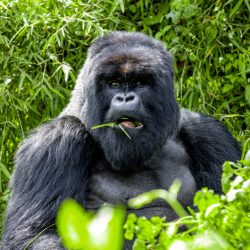Back to eastern DRC — a first visit since the war
Blog | 8/06/09
Hi, this is Wellard again –writing to tell you about the rest of our visit to DRC, a journey of mixed emotions.
After leaving the beekeepers, we traveled another 12 kilometres of bumpy road to the T-junction to the local army base and the National Park authorities’ offices, Rumangabo Station. There we saw an amazing sight: the government army working together with former rebels. This is something that would not have been possible just a few months ago.
We then proceeded towards Rumangabo station to visit the women commonly known as “ba mama ya Wellard”, meaning simply Wellard’s women, or “ba mama ya champignons”: mushroom women. IGCP supports these women (who are either park rangers’ wives or the widows of rangers killed in the line of duty) in producing mushrooms for sale. During the height of the conflict Rumangabo station had been captured by rebels and everyone had to flee. Only recently have people been able to return.
We headed straight to the mushroom lab and found women busy working. I thought life was back to normal. But that impression soon changed when I entered the lab. To my disappointment and shock, everything was gone! More than 200 kg of mushrooms gone… spoiled, with nothing left but the equipment. I felt like crying. All the hard work disappeared and we were back to square one.
The woman leader then told me: “chef tulikibiyaka na ma champignons zetu zika aribika” (Chief we fled and all our mushrooms got spoiled). I was hopeful though, due to the fact that they were still very knowledgeable in the mushroom production process. It’s a pity after the amazing commitment shown by these women, and I still felt really bad. But we had to move on, and before leaving the station we had a quick chat with the Chief Park Warden and some rangers.
It was way past mid-day when we headed to the Bukima ranger station via the almost non-existent road. My driver was really struggling with his steering wheel. We got stuck not in the mud, but in the jagged volcanic rocks that make up a section of the road. We had to push a Land Cruiser! This road was not good before the war, however, and had not been used for almost two years.
At Bukima a number of beekeepers were waiting for us, as well as some members of HUGO (Human Gorilla conflict- a team that is used to help encourage gorillas back into the forest when they leave the Park and go crop raiding). Bukima and the surrounding area is an exceedingly beautiful and open place. From the Park station you can visit three gorilla groups, in addition to enjoying the breathtaking scenic view of Mikeno and Karisimbi Volcanoes.
While I was standing on the hill surveying the amazing Bukima view I felt like a mighty silverback gorilla looking at his bountiful bamboo kingdom. One whose life would be hopeless if this kingdom is destroyed. I tried to measure the effects of the war on people and on our activities and projects. It was tough getting my head around it: how to re-start things when you realise effort alone is not sufficient. You need stability as well. Which is slowly coming back to this area.
Time was quickly running out for us to go deeper into more villages, thus we had to rely only on the warm and emotional (again) brief exchanges that we had with the local people, beekeepers and HUGO members. On the way back we were shown battlegrounds, fronts and enemy lines where the most recent outbreak of war had taken place. I realized the whole IGCP operating area was affected.
Dusk was upon us when we passed the lone volcano still active, the smoking Nyirangongo, a brooding red cloud on top reminding us,“well I am still here, the permanent threat…” .
The Land Cruiser was still dodging holes on the bumpy road near Goma when one of the partners asked me, “Wellard how do we manage to be that close to these people?” My answer was simple: “I don’t know… just be a part of them”. Goma was just ahead….




